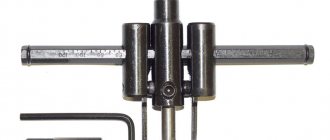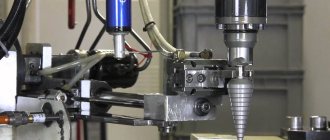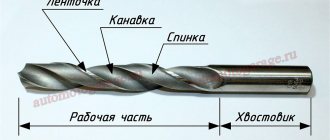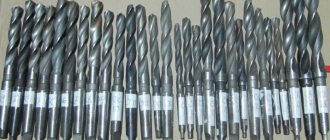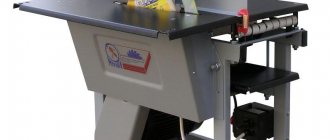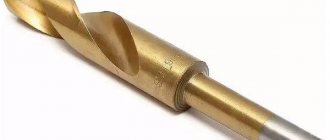The metal bit is designed for drilling large-diameter through holes in sheet and profile metal products. This is one of the few cutting tools that has several parallel names not only in everyday life, but also in professional literature. In GOST 17013-71 it is called a ring drill. But since it has a tubular design of the working part, it is often referred to as a hollow or tubular drill in metalworking textbooks and catalogs of Russian manufacturers. When drilling with such a tool, the cutting process is carried out by teeth located evenly around the circumference of its working end. In appearance, this configuration of the cutting part resembles a crown, so another name for a metal crown is a core drill. And since in its appearance and operating principle it is more similar to a milling tool, you can also find another name - annular cutter.
Types of crowns for metal
The classification of core drills for metal is made according to the following main characteristics:
- material of the cutting teeth of the crown;
- type of shank;
- working part designs;
- geometric size (including maximum drilling depth).
There are two basic types of cutting parts for metal bits: with teeth made of high-speed steel and teeth made of carbide materials. The former are cheaper and less productive, but nevertheless much more efficient than conventional drilling tools. The latter operate at higher cutting speeds and, as a rule, are used when drilling high-chromium steels and hard alloys. The cheapest are bimetallic crowns for metal, in which the cutting part is made of high-speed cutters, and the main body is made of ordinary structural steel.
For core drills, the most common type of shank is Weldon. In addition, tools are produced with Nitto shanks, which are compatible with Weldon, as well as according to the standard of the German company Fein, whose shanks are suitable only for power tools from this company. The working part of metal crowns is characterized by the number of cutting teeth and, accordingly, the number of spiral grooves and ribbons, which can be from four to sixteen or more.
Many manufacturers include a separate group of tools with an extended working part, designed for deep drilling, as well as bits for drilling railway rails.
Carbide bits for metal
In carbide bits for metal, cutting teeth made of carbide are attached to the body by soldering, since all three surfaces are working surfaces. This is a higher performance tool, capable of working at high speeds on alloy metals, stainless steel and aluminum alloys with a high silicon content. Compared to monolithic metal crowns made from quick cutters, it is less resistant to vibrations and variable loads. One of its main disadvantages is the difficulty of replacing or regrinding the cutting teeth if they become dull or broken. There are also core drills with a diamond cutting part, but they are not intended for metal work.
Advantages and disadvantages of the tool
The metal crown cutter in question is characterized by the presence of quite a large number of advantages. They look like this:
- The design of the product is designed in such a way that cutting is carried out along the contour. This point also determines the need to use powerful equipment.
- Core drills and annular cutters for metal are used to obtain a surface with the required roughness index. This cannot always be achieved using a conventional drill.
- You can install metal milling equipment on a wide variety of equipment. Examples include drills and milling machines.
- A similar design option is used for multi-tool processing.
- It can remove quite a large amount of material in one pass. This moment significantly increases the cutting speed.
- To obtain metal shavings requires less energy.
- Increased productivity is ensured by the use of high-speed steel in the manufacture of the cutting edge. It is resistant to heat.
- The required accuracy and cutting speed are ensured.
- During operation, a minimal amount of noise is generated. This can also be called a significant advantage of such a tool.
High productivity is also ensured by the arrangement of a large number of teeth on the working surface.
The crown-type equipment of milling machines has only one drawback - high cost. Difficulties arising during manufacturing increase cost and reduce maintainability. In this case, surface sharpening can only be done using special equipment.
Design and characteristics of core drills
Despite the features of individual models, the basic designs of all metal crowns are approximately the same. All of them consist of a shank, a guide part with spiral grooves and a cutting crown consisting of an even number of teeth (see figure below).
The guide part of such a tool is hollow. When drilling, a metal core is advanced into its internal space, which is knocked out with a special pusher at the end of the operation. The central channel runs through the entire body. A pusher pointed at the end (often spring-loaded) is inserted into it, which, in addition to pushing out the metal core, serves to center the bit on the metal before drilling begins. Also, a centering drill can be attached along the axis of the central channel. In addition, on some models, coolant is supplied to the central channel through a side valve. Due to the large number of cutting teeth, a core drill requires significant cutting force to operate. Therefore, such tools, as a rule, have shanks with flats or grooves for reliable fixation in the chuck. Metal bits designed for conventional drills have a small diameter and cylindrical shanks.
Cutting part
The cutting part of the metal bits consists of an even number of teeth, evenly distributed along the working end of the body. Since this tool is designed for making an annular groove, all its teeth have three cutting edges: one frontal and two lateral (see photo below). For this feature, metal crowns are sometimes called annular cutters, since this cutting method is characteristic not of a drilling tool, but of a milling tool. The number of cutting teeth directly depends on the diameter of the core drill. Small and medium-sized instruments most often have four to six.
Types of shanks
To date, three types of shanks have become the de facto standard for crowns intended for drilling metal (see figure below):
- WELDON. The most common type of shank. It is a short cylinder with a diameter of 19 or 32 mm with three flats. Chucks with WELDON standard sockets can only accept this type of shank.
- UNIVERSAL (other names ONE-TOUCH and NITTO). In accordance with its name, it is a universal shank and can be mounted both in WELDON chucks and in a number of chucks from other manufacturers, except for QUICK –IN standard equipment.
- QUICK –IN. Fit standard of the well-known power tool manufacturer FEIN. Compatible only with devices from this company.
In addition, many manufacturers offer a wide selection of adapters and extensions to accommodate different standards, as well as adapter mandrels for different spindle tapers.
Ring tool device
Drills of this type can be made from a single metal blank or in the form of a composite structure of several elements:
- hollow working crown cylindrical crown with cutting edge;
- guide pilot drill;
- shank for mounting in the drive;
- connecting adapter screws.
This tool consists of:
- The working part is a thin-walled crown, the edge of which is coated with diamond coating or sharpened teeth.
- The body is a transition element that connects the working part with the shank, which is fixed directly into the drill or drilling machine through a standard chuck.
- The crown body is made of steel grades 20, 30, 36.
- Shank.
Collapsible version of the drill
Collapsible drill bit for concrete
In order to assemble a tool from individual elements, a pilot drill is inserted into the shank and its position is fixed with screws. After this, the assembled pair is secured in the crown body on a screw thread.
Metal crown markings
A twist drill and a metal crown are marked almost identically. The shanks of both products are marked with the manufacturer's trademark, material grade, coating type and tool diameter. For core drills, the length of the working part is additionally indicated (see photo below). All other technological characteristics are contained in catalogs, and some of them are applied to the packaging. Moreover, each manufacturer uses its own system for designating product characteristics, which primarily includes the types of processed materials with maximum drilling parameters.
Core drill for metal. Types, features, choice
For such work you need to use specialized equipment and tools, as well as have some skills.
Core drills for metal have a number of significant advantages over conventional twist drills and make it possible to produce through holes of significant diameter in metal products and workpieces.
Types of crowns for metal
Annular drills for metal are a hollow, thick-walled cylinder with sharp cutting teeth on the outer end. Helical grooves are applied along the outer wall of the tool, designed to remove metal chips from the drilling zone. Drills of large diameters and intended for use on drilling machines have a more complex design.
The core drill is used for drilling both small holes with a diameter of 12 millimeters and holes with a diameter of 200 millimeters or more. There are many different classifications of drills depending on the defining parameter.
According to the type of tool or machine for installation on which the drill is intended, they are divided into the following categories:
- Drill-mounted bits - have a cylindrical or hexagonal shank, are designed for processing sheet or thick-walled metal, usually limited to a diameter of 50-65 millimeters.
- Drills for working on magnetic drilling machines have the appropriate type of shank and are characterized by increased strength.
- Core bits for installation on conventional drilling machines have a standard design and differ in the type of shanks.
Depending on the design and material of manufacture, crowns for drilling metal are divided into the following types:
- The tool, made of high-speed tool steel, does not have additional surfacing on the working part or a hardening coating; cutting properties are achieved due to the strength characteristics of the metal and a certain sharpening of the teeth. Such crowns can be re-sharpened, but it is important to maintain the original angle of the tooth profile.
- Crowns made from steels with low strength characteristics, but having carbide deposits on the cutting edge. Their disadvantage is the inappropriateness of re-sharpening the tooth. Large diameter drills will be cheaper than high speed steel drills of the same diameter.
Design and characteristics of core drills
The metal drill bit has a rather complex design compared to conventional twist drills and consists of the following elements:
- Shank. Designed for tight fixation in the chuck of a hand tool or in the spindle of a metal-cutting machine. It has a configuration and cross-sectional shape corresponding to the type of equipment used. It can have a cylindrical, hexagonal shape or have special grooves. Weldon type shanks are commonly used on magnetic drilling machines.
- Center drill. Necessary for precise centering of the core cutter by cutting into the surface layer of the metal being processed. It is fixed in the shank using special clamping screws. It moves back during operation and returns to its original position using a central spring.
- Drill bit. Connects to the shank with a clamping screw. The main working part of the tool. The assembled cutter is usually not made of high-speed steel, but has welded carbide teeth on the cutting end.
- Guide centering rod. This design element is found in an annular drill installed on specialized industrial drilling machines. It is used instead of a center drill and is designed to center the main tool. Also, when starting work, the rod opens the coolant supply valve, which is directed to the workpiece cutting zone. At the final stage of cutting, the rod pushes the cut metal out of the body of the part.
Marking of annular cutters (core drills)
The modern metal-cutting tool market offers core drills for metal of various quality.
Tools from cheap Chinese manufacturers can be produced without markings, which can be used to determine the material of their manufacture and technical characteristics.
More responsible manufacturers usually put markings on the tool shank or at least on its packaging.
The marking must contain designations of the material of manufacture. A domestically made crown drill usually has a high-speed steel grade in its designation. Good options are steels such as R6M5 and grades similar to it in composition and properties.
In foreign-made tools, the marking must contain the abbreviation HSS, which indicates that the steel used is high-speed tool steel. After the letters HSS there is usually an indication of a specific brand according to the standard of the region of manufacture. The designation TCT means that the tool has a cutting part made of carbide teeth welded onto the body.
The designation of a core drill for metal must also include information about its diameter and working length. The diameter value usually ranges from 12 to 100 millimeters.
Pros of core drills
Ring bits for metal have no equal when drilling through holes of large diameter in rolled metal several tens of millimeters thick. When using conventional tools, this operation usually involves drilling followed by incremental reaming or boring. In this case, the entire mass of metal located at the site of the hole is cut off. During the drilling process with a crown, metal is sampled only in a groove located along the perimeter of the future hole, and the main part of it remains intact. This technology has a number of undeniable advantages over traditional drilling. The most significant among them:
- the ability to produce holes with a diameter of up to 200 mm in one installation of the tool;
- high productivity and, as a result, a significant reduction in cutting time;
- energy saving;
- less wear of cutting edges due to their larger number;
- work at high feeds and low speeds;
- effective cooling of the working area.
Perhaps the only drawback of metal crowns is their inability to drill blind holes. Sometimes it is pointed out that these products are much more expensive than conventional twist drills. But here it is necessary to take into account the fact that the total cost (tool consumption, labor costs, energy intensity, etc.) of producing a large-diameter hole with a traditional tool is much higher than with an annular drill with a cutting crown. In addition, due to the presence of a large number of cutting edges, the service life of such a tool is much greater than the service life of twist drills.
What are they used for?
Core drills are widely used to make through holes in sheet metal, wood, plastics, drywall, plywood, and chipboard. The simple technology for drilling large diameters, with the minimum possible application of force, has made these drills an indispensable tool not only for the above materials, but also for other types of work. Special purpose drills are used for:
- obtaining holes of the correct shape in concrete and stone building structures;
- drilling ceramic tiles, natural stone, sheet glass and other fragile materials;
- horizontal drilling when laying utilities;
- production of flat circles and cylindrical workpieces without turning.
To do this, in some cases, the design of the drill (drill) provides for lengthening its working part by adding appropriate inserts.
To work with concrete, only diamond-coated or tipped core drills are used. There are 2 groups here:
C1 – the crown can withstand loads during operation up to 5 MPa.
C2 – the crown can withstand loads during operation up to 2.5 MPa.
Based on the equipment you have, you should choose the crown group itself.
Tips for choosing a tool
Compared to twist drills, metal core bits are expensive and quite difficult to use tools, so they are produced by a fairly limited number of manufacturers. Core drills from Karnasch, as well as from such well-known brands as Kornor, RUKO, Rotabroach, Bosch, TIZ and Enkor, have a high reputation on the Russian market. When choosing a crown for metal, first of all, you need to focus on the production tasks for which it is purchased. It is important to understand in advance what metal or alloy you will be working on, what the diameter and depth of the drilling will be, as well as the capabilities of your power tool in terms of power and type of socket. All manufacturers in their catalogs provide not only the geometric parameters and types of metal bit shanks, but also indicate what materials it is intended for drilling. In addition, they can find recommended cutting conditions and coolant flow rates. The figure below shows a description of the HARD-LINE series core drill with carbide tips and Weldon shank from the Karnasch catalog.
Samoilov S.V. consulting engineerRUKO GmbH
About drilling with core drills
Almost any man, even if he is not a mechanic by profession, has encountered the use of a twist drill for metal at least once in his life and knows what it looks like. But only specialists know about the existence of core drills and know how to use them. In fact, the core drill (core cutter, annular drill, tubular drill, trepan drill) has existed as a type for more than 100 years and is actively used in various industries.
Getting to know the designs
Today we can roughly distinguish three types of core drills.
• the first and simplest type of core drill is bimetallic core drills made of HSS tool steel, which builders are happy to use for drilling plywood, drywall and chipboard, as well as for drilling sheet metal. It would be more correct to call them hole saws. These saws have a cutting part that resembles a hacksaw blade rolled into a circle. Diameter range - from 14 to 210 mm (according to the RUKO catalogue). Such drills have a prefabricated design, a centering drill and a hex shank for a conventional drill chuck.
• the second type is more complex and expensive carbide flat core drills, which are used for drilling metal using powerful hand drills and standard drilling machines. They are called flat because of the small thickness of the processed steel sheet - about 4-5 mm. This tool has carbide brazed inserts, replaceable centering drills and a hex shank. Diameter range - from 16 to 150 mm (according to the RUKO catalogue).
• the third type is core drills, specially designed to work in conjunction with powerful stationary or portable drilling machines. Most manufacturers call them core cutters in their catalogs. Drills are produced entirely from “high-speed cut” (HSS) with a hardness of 62-64 HRC, or the drill body is made of high-grade steel and is equipped with teeth made of carbide plates. We will continue to talk about special crowns in this article. The main technological difference between a core drill and a twist drill is that a core drill can only make a through hole with subsequent removal of the central fragment of the material being processed, while a twist drill can also make “blind” holes.
Design differences:
• a twist drill is a cylindrical rod with a cutting part in the form of two teeth, turning into helical spiral grooves designed to remove chips and form cutting elements. • a core drill is a hollow cylinder that has teeth at the working end that are shaped like saw teeth and a specially designed shank.
Among the features of core drills, we can mention the fact that the drilling diameter cannot be less than 12 mm. This is a design limit due to the thickness of the tooth, the presence of a central hole for the pilot pin, and the need for clearance between the pin and the inner walls of the hollow drill. The maximum diameter of crowns produced today is 150 mm. The maximum length of the working part of the crowns (thickness of the material being processed) is 110 mm with a diameter of up to 100 mm.
Advantages of working with a core drill
1. During the drilling process, only metal is removed along the contour of the hole, i.e., the area of the metal being cut is significantly reduced. As a result, cutting forces and wear of the cutting edges of the tool are reduced, and the service life before regrinding increases. 2. The use of a powerful drive is not required, since the cutting forces are small. Significant savings are achieved on the purchase of the drive. 3. A large number of cutting teeth ensures smooth, shock-free operation. As a result, the surface of the hole has less waviness and roughness than when drilling with twist drills. 4. The absence of pre-drilling and the need for readjustment reduces drilling time, resulting in an increase in labor productivity by 50–120%. 5. It is possible to use portable equipment to make holes with a diameter of up to 150 mm in metal structures of any degree of readiness in any spatial position in factory and field conditions.
About drilling machines
Core drills are not yet widely used in mass production. Modern powerful and rigid machining centers such as Ficep or Peddinghouse typically use large-diameter twist drills with internal channels for coolant supply. But for small-scale production or for construction and installation work, core drills are simply irreplaceable. “Crowns” are used in the manufacture of power transmission line supports, in the installation of rail joints, in shipbuilding, in the manufacture of building structures, and bridges. Accordingly, a separate class of machines has been created for this tool - these are lightweight portable mobile drilling machines on a magnetic base. For example: a machine from RUKO model RS30e, weighing 21.5 kg, is equipped with a magnet with an attractive force of 13000 N (or 1300 kgf) and a 1.8 kW drive and is capable of drilling holes in structural steel with a diameter of up to 100 mm. For a hole with a diameter of 100 mm and a depth of 50-55 mm, it will take no more than 5 minutes. Since modern core drills are inextricably linked with special drilling machines, most machine and drill manufacturers adhere to the same standard for the drill shank and the chuck. For the working diameter of the bit from 12 to 60 mm, the Weldon 19 shank is used, for diameters from 61 to 150 mm, the Weldon 32 shank is used. For the diameter range of 12-60 mm, the leading manufacturers of cutting tools Karnasch and RUKO also produce Universal shanks, which are extended in application Weldon 19 modification (also covers Nitto drill chucks). It is worth mentioning technical delights: the FEIN company produces machines only with the semi-automatic chuck Fein Quick In, for which it has developed its own shank with a diameter of 18 mm, and the Alfra company in its arsenal, in addition to the standard chuck for W19, has the semi-automatic chuck Alfra Rota Quick, for which it has modified the W19 shank , performing one additional countersink.
To conclude the topic of shanks, Weldon 19 shanks are suitable for all manufactured machines with hand chucks (Alfra, BDS, RUKO, Euroboor, Magtron, Evolution, Rotabest, etc.). Universal shanks fit all of these machines, including Nitto machines with the Nitto One-Touch semi-automatic chuck. Fein shanks only fit Fein Quick In chucks. Alfra shanks are suitable for all those machines that use W19 plus Alfra's own semi-automatic Rota Quick chuck. Manufacturers RUKO and Karnasch have in their catalogs drills with Weldon 19, Universal, Fein shanks.
Drilling features and machine selection
In practice, we often encounter situations where the actual service life of a high-speed cutting drill (HSS) or even a carbide drill turns out to be significantly less than expected. How to ensure long-term operation of a drill in practice? To do this, you need to strictly follow the manufacturers’ recommendations, in particular, choose the right cutting speeds, use coolant, accurately and correctly dose the axial feed, and remove chips from the cutting zone in a timely manner. According to reviews from manufacturers, an HSS core drill with a diameter of 20-25 mm, when drilling sheet steel 3 with a thickness of 10-15 mm, is capable of making 500-650 holes (the record was 800 holes), and a core drill with carbide plates under the same conditions should make at least 1000 holes. The choice of crown material is determined primarily by the type of material being processed. The general rules are as follows: for working on structural steels and in conditions of insufficient rigidity of the machine-tool-workpiece system (presence of vibrations), choose the HSS crown material; when processing alloy steels and stainless steel, choose a crown with TV plates. It must be remembered that TV plates “really don’t like” vibrations that can occur when processing thin sheets. In both cases, you need to correctly select the cutting speed and axial feed. All manufacturers of core drills provide special tables in their catalogs that allow you to select the correct drill speed depending on the diameter of the hole and the type of material being processed. But for proper use of crowns, it is necessary to have machines with a large range of speed adjustments; It is better if it is a machine with smooth speed control.
| Let's try to simulate the real situation of selecting the speed and choosing a machine. There is a workpiece: steel sheet 20, 50 mm thick. It is necessary to drill a hole with a diameter of 50 mm. As a tool, we select a drill HSS L=50 mm from the RUKO catalog (article 108550). In the same catalog, using the table, we select the recommended cutting speed for machining unalloyed steel with an HSS drill - this is 30-35 m/min. The number of revolutions (N) can be calculated independently using the formula N = 1000 • V / π • D (here V is the optimal cutting speed in m/min, π is 3.14, D is the drill diameter in mm) or taken from the table in the RUKO catalog. The recommended speed is 191 rpm. The RUKO RS25e machine is ideal for this work; it has a gearbox with two stages: 1st stage = 250 rpm and 2nd stage = 450 rpm and allows you to smoothly electronically change the speed in 1 stage from 100 to 250 rpm and in 2 stages from 180 to 450 rpm. |
A big advantage of machines on a magnetic base is the ability to organize lubrication and cooling of the cutting zone in any position of the machine: floor, ceiling, horizontal. For the vertical floor position of the machine, the coolant supply is organized from the standard upper tank by gravity. Coolant is supplied through the chuck and the central hole in the core drill directly to the inner surface of the teeth. When the machine is mounted vertically on the ceiling, a special grease (Litol type) is placed in the core drill so that the coolant does not pour onto the operator’s head and short-circuit the electronics on the machine. If the drilling axis is horizontal, you can use a tank with a pump, in which excess air pressure is manually created by a pump, or install a standard tank next to the machine on a tripod to supply coolant by gravity. Certain problems may arise for inexperienced operators when choosing the pressure force on the manual feed handles of the drilling machine spindle and, accordingly, the axial feed speed of the drill. You will not find this data in manufacturers' catalogs. It all depends on the experience and skill of the operator. We can only give general practical recommendations for revolutions and axial feeds for HSS drills.
| Material | Drilling speed m/min | Drill feed mm/rev |
| Structural steel | 30-35 | 0,1-0,15 |
| Alloy steel | 20-25 | 0,08-0,10 |
| Stainless steel | 18-45 | 0,08-0,10 |
| Cast iron | 10-15 | 0,12-0,20 |
| Non-ferrous metals, aluminum | 60-70 | 0,22-0,45 |
It is worth mentioning that today a number of manufacturers have machines on a magnetic base with an automatic spindle feed system, which practically eliminates the human factor when choosing axial force. In particular, the Nitto company produces several models of drilling machines on a magnetic base, equipped with a separate automatic feed unit. To prevent drill bits from breaking, this machine is equipped with an automatic safety device that shuts off feed and rotation in case of overload. The disadvantage of this technique is its high cost, approximately 2.5 times more expensive than a manually driven machine. At the opposite pole there is an original technical solution from FEIN - this is a powerful Fein KBH 25 hand drill with speed control, which is equipped with a semi-automatic chuck for mounting hole saws with a Quick IN-PLUS shank. This system allows you to manually drill holes with a diameter of up to 25 mm to a depth of up to 20 mm, but the life of the drill depends entirely on the skill of the performer.
How to extend the life of a drill?
A pressing issue in the operation of core drills is extending the service life of the tool by re-sharpening. It is not possible to sharpen the crown by eye by hand. Manufacturers do not even indicate cutting angles on the front and rear edges. But this problem has been solved radically. There are several companies that produce portable machines for sharpening hole saws. In particular, the Ruko catalog presents model 1250 for sharpening drills with diameters from 12 mm to 100 mm. Sharpening along the front and back surfaces of the tooth is carried out without any manual adjustments using standard dividing disks, selected according to the number of teeth on the crown. HSS drills can be resharpened up to 6-8 times. To increase tool life when working on alloy and stainless steels, tool manufacturers actively use the spraying of wear-resistant coatings. In particular, RUKO offers core drills made of high-speed cutting machine (HSS) coated with titanium aluminum nitride (TiAlN). This coating has a surface hardness of 3000 HV and a heat resistance of 900 °C, which is comparable to that of a hard alloy. The coating gives HSS tools unique properties, allowing them to process hardened steels at cutting speeds previously only available to carbide, while completely eliminating the problem of cutting edge chipping, which is typical for carbide, due to vibrations caused by the weak rigidity of the part-tool-machine system. An additional advantage is that the HSS drill is resistant to bending and impact loads. Sputtered core drills have one drawback - their high price.
Conclusion
The technology of drilling with core drills, and accordingly the machines and tools considered, have a great future. As a summary, I would like to note the huge role played today by portable drilling equipment equipped with core drills - these are all types of production and installation work related to metal structures: in a workshop, on a construction site, on the railway, in the engineering troops, in the Ministry of Emergency Situations. Without exaggeration, we can say that today this equipment has become indispensable for hundreds of enterprises in our country.
Sharpening core drills
The cutting tooth of a metal crown is sharpened on three sides with precise control of both the angular positioning of the abrasive wheel and the inclination of the drill relative to its surface.
Therefore, machines for sharpening core drills are quite complex mechanical devices, and sharpening itself requires professional skills. This machine can sharpen core drills of various diameters and with different numbers of teeth. In addition, its clamping device is designed for all types of modern shanks found in various metal bits (Weldon, Nitto, Fein, etc.). This is quite expensive and complex equipment and it makes sense to purchase it only if you intend to provide tool sharpening services. And in order to return the cutting edges of a metal crown to their original sharpness, it is enough to contact a service company with the appropriate competence. The price of such a service is not very high. For example, sharpening a Karnasch GOLD-LINE series core drill with a diameter of up to 25 mm will cost 500–600 rubles. Sharpening work for Anchor metal crowns and Hilti and Makita bimetallic annular drills will cost slightly less.
When sharpening a crown for metal, the protective coating of the cutting edges is completely removed. The price of sharpening work for such a tool is openly published on the websites of specialized enterprises. But we couldn’t find out how much a new titanium nitride coating would cost. If anyone has such information, please share it in the comments.



